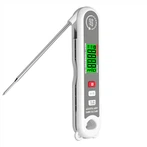Analysis of some knowledge of polarizing microscope
Structure of Polarizing Microscope
1. Eyepiece, 2. Lens barrel, 3. Bertrand mirror, 4. Coarse handwheel, 5. Fine-tuning handwheel
6. Mirror arm, 7. Mirror holder, 8. Upper polarizer, 9. Test plate hole, 10. Objective lens
11. Stage, 12. Condenser, 13. Locking aperture, 14. Lower polarizer, 15. Reflector Reflector
Classification of Polarizing Microscopes
1. Binocular Polarizing Microscope
2. Computer-type polarizing microscope
3. Digital polarizing microscope
4. Transflective Polarizing Microscope
Applications of Polarizing Microscopy
1. In organisms, different fibrous proteins, such as collagen, elastic fibers, tension fibers, muscle fibers, etc., show obvious anisotropy. Details of the molecular arrangement in these fibers can be obtained using polarized light microscopy prior to measurement.
2. Biological materials with crystalline structures, such as starch grains, can be observed with a polarizing microscope.
3. Study living cells of animals and plants, such as spindle filaments in plant cells.
Equipment Requirements for Polarizing Microscopes
a. Light source: It is best to use monochromatic light, and general microscope inspection can use light source.
b. Eyepiece: An eyepiece with crosshairs is required.
c. Condenser: In order to obtain parallel polarized light, a swing-out condenser that can push out the upper lens should be used.
d. Bertrand lens: an auxiliary part in the optical path of the condenser, which is an auxiliary lens that magnifies all the primary phases caused by the object into a secondary phase, which can ensure that the eyepiece is used to observe the planar pattern formed in the rear focal plane of the objective lens .
Precautions for the use of polarizing microscope
1. Do not loosen all fixing screws (except the stage stop screw).
2. The lower polarizer is easy to fall off, so don't rotate it frequently.
3. Lower the objective stage slightly before placing the slice, with the cover glass facing up and not touching the objective lens. Do not apply pressure to the stage while moving the slice.
4. Do not put the sheet on other items, so as not to drag and break. Microscope use, microscope use, maintenance precautions
5. When changing the objective lens, rotate the objective lens turret, do not turn the objective lens.
6. When using the upper polarizer, test plate and Bertrand lens, pull and send lightly.
7. If the microscope is not used for a long time, the power switch on the mirror base should be turned off, or the brightness should be adjusted to the minimum.






